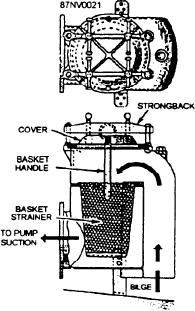valves and fittings industry. A standard identification
drain inlet and a 2-inch IPS outlet. The other has an
marking in this system usually includes the
8-inch drain inlet and a 3-inch IPS outlet.
manufacturer's name or trademark, the pressure and
Strainers are located in all piping lines to prevent
service for which the product is intended, and the size
the passage of foreign matter. They must be installed
(in inches). When appropriate, material identification,
so that the flow will be through the strainer element.
limiting temperatures, and other identifying data are
The bilge suction strainer (fig. 15-21) is an example of
included.
a basket strainer. Some systems use duplex strainers.
The MSS standard identification markings are
The duplex strainers allow the fluid to continue flowing
generally cast, forged, stamped, or etched on the
while one of the strainers is removed for cleaning.
exterior surface of the product. However, in some
Therefore, you do not need to secure the system to clean
cases, the markings are applied to an identification plate
the strainers.
rather than to the actual surface of the product.
IDENTIFICATION OF
The service designation in the MSS system of
VALVES, FITTINGS, FLANGES,
marking usually includes a letter to indicate the type of
AND UNIONS USING THE
service and numerals to indicate the service pressure
MANUFACTURERS
rating in pounds per square inch. The letters used in
STANDARDIZATION SOCIETY
service designations are A (air), G (gas), L (liquid), O
(MSS) MARKING SYSTEM
(oil), W (water), and D-W-V (drainage, waste, and
vent).
Many valves, fittings, flanges, and unions used on
naval ships are marked with some sort of identification
When the primary service rating is for steam, and
symbol. Valves and fittings made on board repair ships
when no other service is indicated, the service
and tenders, or at naval shipyards are usually marked
designation may consist of numerals only. For
with symbols indicating the manufacturer (the ship's
example, the number 600 marked on the body of a valve
number or the insignia of the naval shipyard), the size,
would indicate that the valve is suitable for steam
the pattern number, the melt or casting number, and the
service at 600 psi. If the valve is designed for liquid at
material. They may also be marked with the date (year)
600 psi, the service designation would be 600 L.
of manufacture and with an arrow signifying the
Service designations are also used in combination; for
direction of flow.
example, the marking 3000 WOG would indicate a
product suitable for water, oil, or gas service at 3000
Many commercially manufactured valves, fittings,
psi.
flanges, and unions are identified according to a
standard marking system developed by the
In the MSS marking system, the material
Manufacturers Standardization Society (MSS) of the
designation may be either spelled out or abbreviated.
Most cast, wrought, or forged steel products are marked
with the word STEEL. Malleable iron is identified by
the abbreviation MI on newer products. On older
products, the abbreviation MAL or MALL is used.
Ductile cast iron is identified by the word DUCTILE or
by the abbreviation DI. Other symbols used for
material identification include the following:
AL . . . . . . . . . . Aluminum
B . . . . . . . . . . . Bronze
CS . . . . . . . . . . Carbon steel
CI . . . . . . . . . . . Cast iron
HF . . . . . . . . . . Cobalt-chromium-tungsten
alloy (hard facing)
CU NI . . . . . . . . Copper-nickel alloy
NI CU . . . . . . . . Nickel-copper alloy
Figure 15-21.--Basket strainer.
15-18






